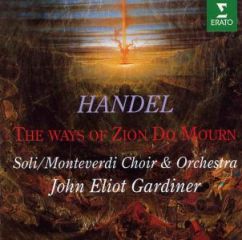Handel - The ways of Zion do Mourn (Gardiner) [2008]
Handel - The ways of Zion do Mourn (Gardiner) [2008]

01. Sinfonia
02. The ways of Zion do mourn
03. How are the mighty fall'n
04. She put on righteousness
05. When the ear heard her
06. How are the might fall'n (reprise)
07. She deliver'd the poor that cried
08. How are the mighty fall'n (reprise 2)
09. The righteousness shall be had in everlasting remembrance
10. Their bodies are buried in peace
11. The people will tell of their wisdom
12. They shall receive a glorious kingdom
13. The merciful goodness of the Lord
Norma Burrowes (Soprano) Charles Brett (Countertenor) Martyn Hill (Tenor) Stephen Varcoe (Baritone) Monteverdi Choir, Monteverdi Orchestra John Eliot Gardiner – conductor
England lost a beloved monarch when Queen Caroline died, but Handel lost a longtime friend and intimate patron. The daughter of the Margrave of Brandenburg-Ansbach, Caroline was born in 1683 and grew up in the court of Sophie Charlotte and her mother, the electress Sophie, where she may have met Handel for the first time in 1698. She married Sophie’s grandson, the electoral prince Georg August (later George II) in 1705. Handel composed a set of Italian duets for her following his appointment to the post of Kapellmeister to the Elector in Hanover, and became music master to her daughters after her eventual arrival in London. After George II succeeded his father as king, Caroline enjoyed much greater popularity than her husband. She was widely regarded as an accomplished musician and intellectual, and her letters to her former tutor and friend Gottfried Wilhelm Leibniz later instigated the Leibniz-Clarke correspondence, a famous debate touching on issues in theology, physics, and philosophy. After her death on November 20, 1737, Handel received a commission to compose her funeral anthem and a text compiled from the books of Lamentations and Job by Edward Willes, the sub-dean of Westminster Abbey. At the funeral, which took place on December 17, “…the great Bells of the Cathedral of St. Paul and of many Churches in London and Westminster were tolled. And the Tower Guns kept firing all the while, at a Minute’s Distance between each.” Handel’s funeral anthem received equally monumental treatment; as one contemporary wrote, it was performed by “near 80 vocal performers and 100 instrumental from His Majesty’s band, and from the Opera, etc.”
Although “The Ways of Zion do Mourn” was constructed from various biblical sources, it forms a cohesive narrative that describes the subjects’ sorrow, the queen’s virtues, and hope for the future. Handel responds to this narrative structure with equal complexity, incorporating a variety of emotions into his musical reading. Mourning and sorrow are the predominant feelings in the opening chorus, “The ways of Zion do mourn.” Handel’s gentle approach to the text is particularly noteworthy: while the words provide ample opportunity for vivid depiction, Handel carefully avoids melodrama by letting one or two phrases (e.g., “her people sigh”) inspire motives that subsequently pervade the entire section. A more reminiscent mood comes to the forefront with “When the ear heard her” and “She delivered the poor,” whose elegant melodies and upbeat tempos contrast strikingly with the powerful repeated interjections of “How are the mighty fall’n.” The chorus “Their bodies are buried in peace” simultaneously portrays the paradoxical states of eternal peace and life, while the people “shew forth their praise” in resolute counterpoint in the following “The people will tell of their wisdom.” Grief and adoration ultimately give way to faith in “The merciful goodness of the Lord,” in which the chorale-like musical texture takes the work to its close. ---Jennifer More Glagov, baroque.org
download: uploaded anonfiles yandex 4shared solidfiles mediafire mega filecloudio nornar
Zmieniony (Poniedziałek, 23 Grudzień 2013 09:31)








